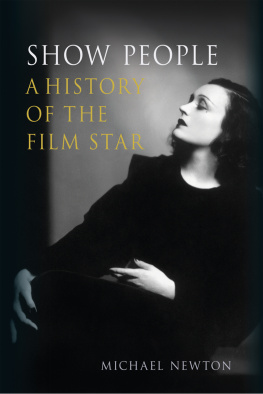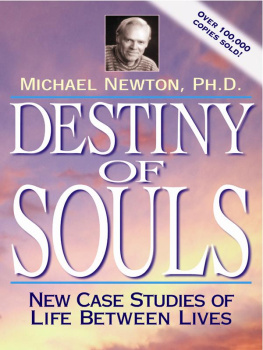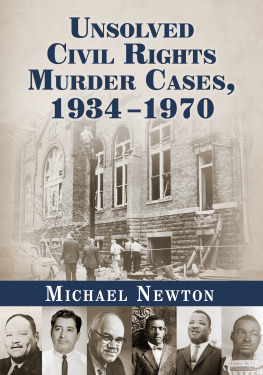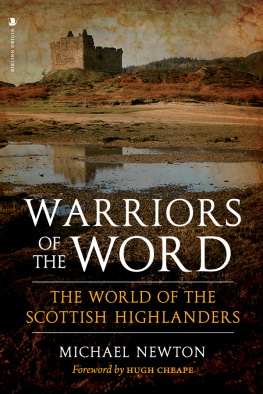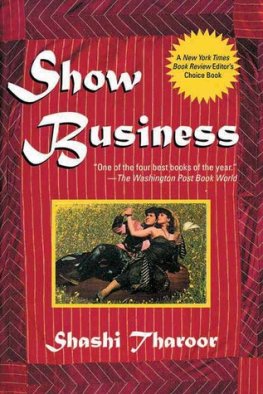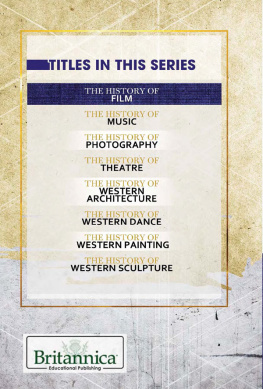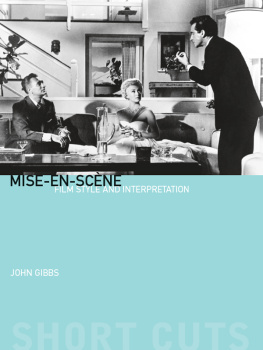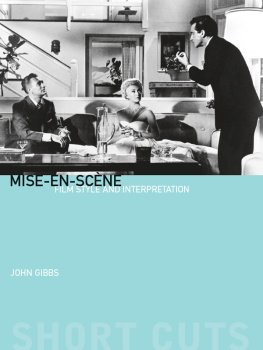SHOW PEOPLE

SHOW PEOPLE
A HISTORY
OF THE
FILM STAR
MICHAEL NEWTON
REAKTION BOOKS
For Lena
Published by
REAKTION BOOKS LTD
Unit 32, Waterside
4448 Wharf Road
London N1 7UX, UK
www.reaktionbooks.co.uk
First published 2019
Copyright Michael Newton 2019
All rights reserved
No part of this publication may be reproduced, stored in a retrieval system, or transmitted, in any form or by any means, electronic, mechanical, photocopying, recording or otherwise, without the prior permission of the publishers
Page references in the Photo Acknowledgements and
Index match the printed edition of this book.
Printed and bound in Great Britain
by TJ International, Padstow, Cornwall
A catalogue record for this book is available from the British Library
eISBN 9781789141849
CONTENTS
No more festival of stars! cried one of the more vociferous orators. What we need is a festival of dialogue!... I was invited to speak. Organize a symposium by all means, I said, but dont forget what happened at this years gala opening. The inaugural film had been a revival of Gone with the Wind, and when Clark Gable made his first appearance on the stairs of Tara the festival audience went wild with applause. Had his ghost appeared on the Croisette, pandemonium would have ensued. Show business couldnt dispense with stars.
ROMAN POLANSKI on the Cannes Film Festival, 1968, in Roman Polanski, Roman (London, 1984), pp. 2567
CLEOPATRA: Think you there was or might be such a man As this I dreamt of?
DOLABELLA: Gentle madam, no.
CLEOPATRA: You lie up to the hearing of the gods.
But if there be nor ever were one such,
Its past the size of dreaming. Nature wants stuff To vie strange forms with fancy, yet timagine An Antony were natures piece gainst fancy, Condemning shadows quite.
WILLIAM SHAKESPEARE, Antony and Cleopatra (v.2)
Theres no people like show people.
IRVING BERLIN
PREFACE
I n the Bollywood film Fan (2016), Shah Rukh Khans film-star character, Aryan Khanna, declares, Without my fans, I am nothing. A star playing a star, Khan riffs on his own enormous fame. Yet Khan also plays Gaurav Chandna, the super-fan, a young man given over to the karaoke appropriation of his idol, a man whose presence he performs on stage and whose image covers his bedroom walls. Aryan Khanna is Gauravs god. In taking both roles, Shah Rukh Khan helps us to perceive the symbiotic relationship between star and fan. The film is about how one life may impose on another, either as an image that seduces, or, more frighteningly, as a strangers bullying physical demand. Power seeps into both sides of this relationship, the power of fame and wealth that is the stars possession, the power to make and unmake the star that is the fans prerogative. Moreover, playing both roles lets us feel how Khan, that distant film star, was himself once ordinary, just another Delhi boy like his stalker. Doubling proliferates through the film, even as, in one scene, the star plays the fan playing the fictional star posing with the waxwork of the original star at Madame Tussauds.
The film fabricates a double take that draws on the essential divide in Khans on-screen persona, one that has long combined both the gauche with the urbanely suave. In Chennai Express (2013), opposite Deepika Padukone, Khan plays a forty-year-old perpetual adolescent who contrives to turn his underdogs clumsiness into heroic self-assurance. Like Cary Grant, his poise and grace are ready to collapse into a sudden gracelessness. Khan began his career as a villain, became a romantic lead in Dilwale Dulhania Le Jayenge (1995), and now can move between comedy, action adventure and more challenging roles. He has embraced the actors turn for self-transformation, becoming a man with Aspergers syndrome in the message film My Name Is Khan (2010) and a self-destructive drunk in Devdas (2002).
Fans message is that we should live our own lives, not live through others, not even the others at home in the shiny fictions of cinema. Yet this humble truth is one that depends on the glamorous impact of the star himself. Fan emerged from a culture where the star system persists in unchallenged strength. In the world of Bollywood, the star is at once more removed from the world of his fans and readier to let himself appear to them. Just as his star-character does, Shah Rukh Khan similarly comes each Sunday to a raised stage built on the walls of his mansion and waves out, physically present, a man like them, to the mass of adoring fans below. They are his worshippers and his owners, the source of the capital that built the house, just as he becomes for them the potent source of shared dreams and aspirations. The fans gain a sense of connection; the star gains wealth and prestige, a life sustained by anonymous adoration. In Fan theres no conventional romantic interest beyond that forged between the two men that Shah Rukh Khan plays; by analogy, hes playing someone in love with himself.
Shah Rukh Khans film indeed the very fact of his fame upon which the film draws shows how even now the age of the film star is still with us, even at a moment when the stars are readily critiqued or exposed, stripped out of a film they have already completed, as happened to Kevin Spacey in All the Money in the World (2017), or turned on for bad choices or despised opinions. This moralistic response to the star, this swift transformation from adoration to condemnation, has always been an element in our response to cinema. Since the beginnings of film-star culture, the star has been apt to turn into a source of scandal, someone to be built up and then pulled down. Love quickly hardens into hate. Fan likewise tells us of the stars power, but also of their vulnerability. The uniqueness they sell readily metamorphoses into hubris. Ultimately what do we want from the star, what role do they play for us among our public dreams, our private fantasies?
Fame proves transient; stars are soon forgotten. It is no longer a given that the cinema of the past will survive into a future beguiled by other, more compulsive forms of virtual world, or in a society that finds the values of old films to be wanting, or regrets the shabby lives, or the privileged gender or ethnicity of those who made them. Yet despite their apparent fading, still they endure, a continuing pervasive presence in the cultures that first celebrated them. As in Johann Peter Hebels story An Unexpected Reunion (Unverhofftes Wiedersehen) of 1811, where an old woman encounters her long-dead love, embalmed still in all the beauty of his youth by the salt mines in Falun, cinema disinters the youth, the beauty of the past. Every film preserves a person as once did those salt mines. The star remains vivid there, even as we age: in my youth, I loved the 1970s David Bowie and Audrey Hepburn of the 1950s and 60s; they were once much older than I, then the same age, and now rather younger. The stars are caught in the dynamic stasis of those performances even as I, their viewer, find myself transformed by time.
This book hopes to be an extended critical meditation on the film star, carried out by means of forty separate essays covering fifty different stars. Each essay acts as an individual case history, examining the work and presence of many different actors from across the world. The book explores the film star as a type, a concept and a phenomenon. It does not attempt to provide an overview of film stardom as such, and still less an exhaustive account of all the myriad stars. It builds up a picture of film stardom from individuals and through responses to individual films. It aims not just at elucidating through practical examples the workings of the star industry, but at illuminating what moves us in a film, in an actors performance. Its ultimate subject is cinephilia, that antiquated ardour. The book may consider the actor as auteur, the author of the film, but more than this it is concerned with our relationship with the film star as the source of The role lives and dies with that actor, that star; many people may play Hamlet, but, as

